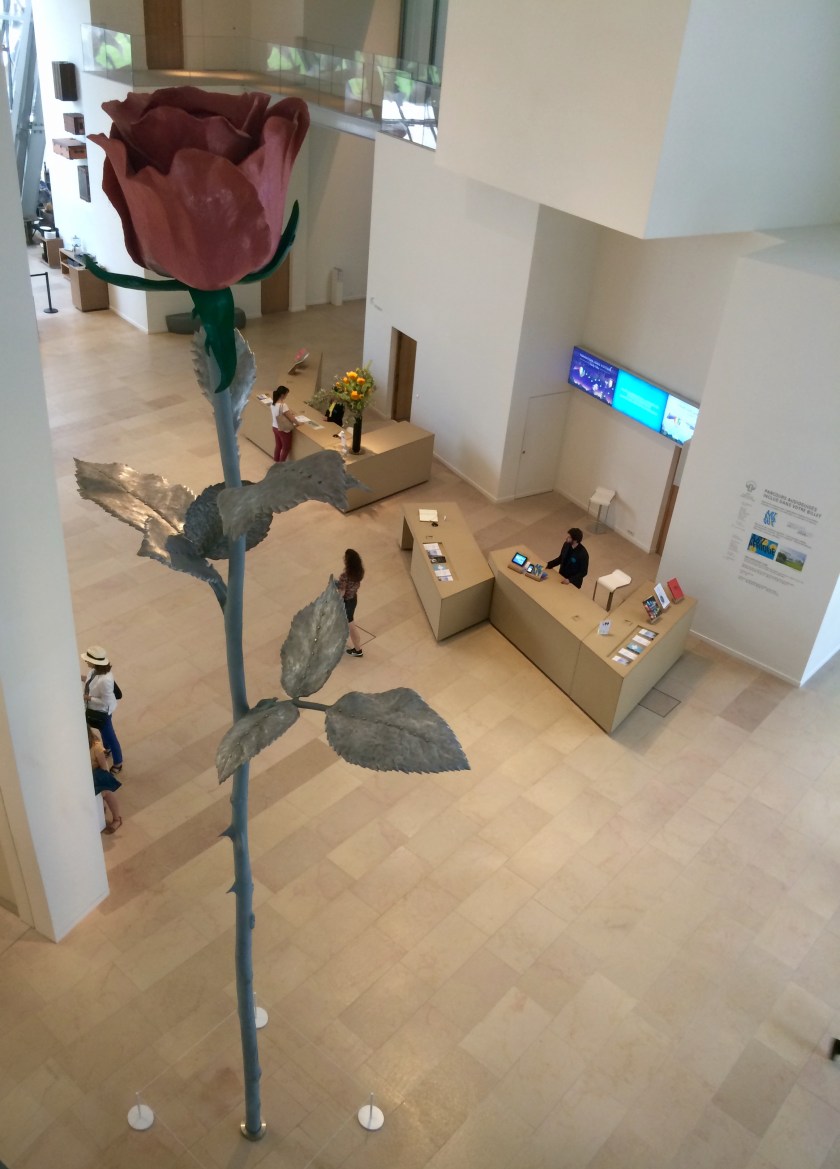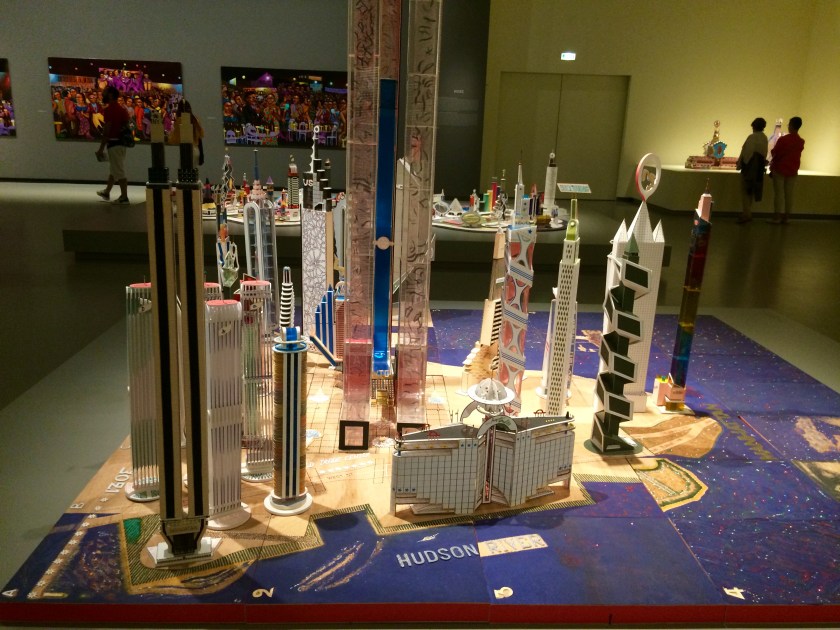A visit to the Louis Vuitton Fondation of Contemporary Art in Paris is a must, if only to admire (gape at!) the building, which was designed by famed architect Frank Gehry. Construction of the museum began in March 2008, and was plagued by many lawsuits and appeals from people who were against building in the Bois de Boulogne, the largest park in Paris. However, the permits were finally obtained and the museum opened in October 2014. Its cost was supposed to be $143 million, but, according to some sources, it finally rose to around $780 million.
Be that as it may, it is an extravagant structure which definitely adds to the must-see list of Parisian sights, and those responsible for its design and construction have won several architectural awards in France and the US.

The building takes the form of a boat’s sails inflated by the wind. These glass sails envelop the “iceberg”, a series of shapes with white, flowery terraces; they are made of 3,584 laminated glass panels, each unique and specifically curved to fit the shapes drawn by the architect. The building incorporates interesting water features as well as commissioned site-specific installations by, amongst others, Ellsworth Kelly, Olafur Eliasson and Adrián Villar Rojas.

The LVF houses an extensive permanent collection, including works by Jean-Michel Basquiat, Gilbert & George and Jeff Koons. This summer, a major temporary exhibition showcased art from sub-Saharan Africa, made up of three distinct exhibits: offerings from the foundation’s own archive, a selection from Jean Pigozzi’s prestigious collection and an overview of the best in South African contemporary art.
It is obviously difficult for one exhibition to encompass the scope and variety of a continent made up of 54 different countries, but there was terrific work from artists we rarely see, or sometimes have never seen at all. Despite all the talk about the globalisation of the contemporary art world, art from Africa continues to be woefully under-represented.
I personally was galvanized and overwhelmed by what was on offer. Since I am no expert on the subject of African art, and it would be easy enough for anyone to look up any information needed, I will only attempt here to show a small sample of the works which enthused me.
Benin artist Romuald Hazoumé is of prestigious lineage, since his ancestor was a high priest of the Fâ at the court of the King of Port-Novo. His art reflects his close connection with his Yoruba culture, where masks hold center stage: his were made of recycled plastic cans and other household objects.

Rigobert Nimi is from The Congo and a lot of his work uses found objects. He had contributed enormous constructions resembling amazing imaginary spaceships.

Senegalese artist Seni Awa Kamara learnt pottery from her mother, who made everyday objects, but developed her own radically innovative style. She creates female figures to whom are attached many tiny statues meant to represent children, in animal or human form.

Activist Chéri Samba is inspired by everyday life and touches on a wide range of subjects from current political, economic, social and cultural events in Kinshasa – such as ecological problems, corruption, tragic events, etc. He incorporates text in his work, both in French and Lingala, as in the painting below, which highlights the problem of obtaining clean water.

Bodys Isek Kingelez, who is from the Democratic Republic of the Congo, builds models of buildings with unusual shapes and bright colors, using recovered materials. Some are individual constructions, and some entire urban simulations, such as his enchanting rendering of an imaginary Manhattan, below.

Artist Abu Bakarr Mansaray, from Sierra Leone, taught himself chemistry, mathematics and electronics using school textbooks. In 1998 he fled the civil war and moved to the Netherlands where, in his art, he evokes the war and its traumas, but also UFOs and aliens of which he considers himself the interpreter. He draws upon his scientific knowledge to produce monumental drawings using pencil, ballpoint pen, felt-tip markers and colored pencils.

A Heath Robinson-esque contraption, and, below, a detail from another painting.

Artist John Goba was initiated by his grandmother into a secret female society. Inspired by this, he makes statues evoking traditional knowledges and tales of various ethnic groups, using wood and porcupine quills.

Benin artist Calixte Dakpogan comes from a family of ironmongers. He too reinvents the mask, either using found materials, or cheap everyday made in China objects, such as safety pins, beads, ballpoint pens etc.

Photographer Seydou Keïta (Mali, 1921-2001), is considered one of the greatest photographers of the late 20th century, and was one of the few artists whose work I’d seen before. Through a large number of exceptional portraits he painted a testimony of Malian society from the end of the Second World War through to Independence.

Even a short break for lunch was not devoid of artistic stimulation, since we sat under this lovely installation of paper fish in the restaurant.

After lunch I continued upstairs, to the part of the exhibition entitled Being There, showcasing some of the most important South African artists. Legends of art such as William Kentridge, Jane Alexander, David Goldblatt, David Koloane and Sue Williamson were featured – artists who helped shape the local art scene and also influenced the younger generation, many of whom were also exhibited here. Sadly, by then I was suffering from a surfeit of visual stimulation, so I skimmed over most of the works and only paused for a disturbing installation by David Koloane, whose work is devoted to the chaotic energy of Johannesburg. His art has distinct political and social overtones, and street dogs, ubiquitous in the townships, put in multiple appearances.

Last, but not least, I sat for a few minutes to watch the latest video production of William Kentridge, Notes Towards a Model Opera, which played simultaneously on three large screens (video below). Kentridge, an artist who experienced apartheid as a white man, has long been a favorite of mine.
It would have been nice to have been able to go back before the exhibition finished (on September 4), because it was impossible to take in such a wide range of extraordinary talent in detail and all at once. Even in this post it was too much to incorporate all the photographs I took, or present all the artists whose work I liked.


Wow this is so amazing! Thanks so much Marina for sharing this! The building is spectacular and everything else! So much variety and amazing art!
LikeLiked by 1 person
Yes, I wished I could have gone a second time, there was too much to take in at once🌺
LikeLiked by 1 person
I can imagine. What I saw on your post was so cool!
LikeLiked by 1 person
Wow! Marina, this is overwhelming in scope and varity – a stunning post and I’m awe of all the art. I’ve never seen anything quite like the video exposition at the end – powerfully effective and thought-provoking. Well done for putting all this together in such a coherent and interesting post. ps. the building itself is a fantasti work of art – it would take me a while to enter as I’d just want to stand and gawp at it!
LikeLike
The YouTube video is just a fragment – the whole thing lasted for 10-15′ and in the beginning there were various panels with cool slogans ‘Find the less good idea’ – ‘Nationalize the heavens’ – ‘Love the mother’. I wish I could have gone a second time, i got very tired at the end, there was just too much. And the building itself – my photo does not do it justice, we spent a lot of time gawping and wandering around. 🌹
LikeLiked by 1 person
A spectacular building filled with intriguing art works.
LikeLiked by 1 person
You were indeed blessed to visit such an awesome exhibition. 🌼🌼🌼
LikeLiked by 1 person
I know! 🌺
LikeLiked by 1 person
Thank you! Have not been to Paris since this gallery opened: methinks it alone is worth the trip even from the Antipodes. Fabulous building: would like to walk around it at dawn and sit down somewhere to absorb at twilight . . . and that fantastic display of the talent, imagination and variety from so many African countries is just mindblowing . . .
LikeLike
Adding to the list of things to see in Paris next time. Thanks for sharing this fascinating journey inside an amazing building!
LikeLiked by 1 person
You make a good case for a visit
LikeLiked by 1 person
Whew! What an expansive post! Some of the works you feature were really thought provoking Disturbing is one word you could use for the street dog march by David Kaloane. I need to ponder more I think.
LikeLike
I know, there was a lot to take in. I have more photos, there was a photographer who’d done a study of African hairstyles, all backs of people’s heads, so fun! By the time I got to the South Africa bit, I was exhausted.
LikeLiked by 1 person
I know what you mean. Sometimes the sensory overload is overwhelming. Less can be more when it comes to viewing exhibitions. Like the idea of photographing African hairstyles. They can be so different from the western ones.
LikeLiked by 1 person
A fascinating collection, and housed in an amazing space.
Best wishes, Pete.
LikeLiked by 1 person
This is an amazing museum, thank you for “taking me” to visit it. The art is filled with such strong emotion as well as cultural and political implications. Every piece was a wonder to see through your photos, but I found the restaurant fish especially interesting because we also had a view of the Gehry building from the inside. It appears, as I unfortunately suspected, chaotic. You did a great job of showing the exhibition and giving info about the artists but I can see how it would have overwhelmed you by the end of the day. Still, very wonderful.
LikeLike